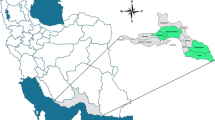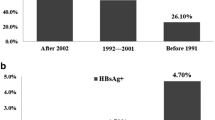Abstract
Hepatitis E virus (HEV) is an emergent virus of global importance. Previous studies of HEV infection in China mainly focused on the rural areas. This work aims to study the epidemiology of HEV in a large urban environment. With a registered population of 10 million, the dense city of Wuhan presents itself as a prime opportunity to better understand this emergent virus. The epidemiological data from 2011 to 2016 were analyzed. A cross-sectional study on the seroprevalence of anti-HEV IgG was conducted among the general population (age range 0-59) in 2013. Serum and fecal samples of hepatitis E patients were collected over a period of two years: serum samples were tested for anti-HEV IgM and IgG, and fecal samples were tested for HEV-RNA. The overall seroprevalence of anti-HEV IgG was 35% in Wuhan. Among 415 hepatitis E patients, 286 cases (68.9%) were positive for HEV-IgM, 108 cases (26%) were positive for HEV-IgG alone, and 21 cases (5.1%) were negative for both IgM and IgG. Phylogenetic analysis showed that the detected genotype of HEV was genotype 4. Reported cases occurred sporadically throughout the year with the peak value appearing in the first quarter and a large proportion of male cases (2.1:1). The incidence increased with age for persons under 60 years, reaching its peak level after 60 years of age. Wuhan is endemic for HEV with its currently detected genotype being genotype 4. It is estimated that 68.9% hepatitis E cases were due to primary infection between 2012 and 2013 in Wuhan.



Similar content being viewed by others
References
Aye TT, Uchida T, Ma XZ, Iida F, Shikata T, Zhuang H et al (1992) Complete nucleotide sequence of a hepatitis E virus isolated from the Xinjiang epidemic (1986–1988) of China. Nucleic Acids Res 20:3512
Abravanel F, Chapuy-Regaud S, Lhomme S, Miedouge M, Peron JM, Alric L et al (2013) Performance of anti-HEV assays for diagnosing acute hepatitis E in immunocompromised patients. J Clin Virol 58:624–628
Arankalle VA, Paranjape S, Emerson SU, Purcell RH, Walimbe AM (1999) Phylogenetic analysis of hepatitis E virus isolates from India (1976–1993). J Gen Virol 80(Pt 7):1691–1700
Emerson SU, Anderson D, Arankalle A, Meng XJ, Purdy M, Schlauder GG et al (2004) Hepevirus. In: Fauquet CM, Mayo MA, Maniloff J, Desselberger U, Ball LA (eds) Virus Taxonomy. Elsevier, London, pp 851–855
Guo QS, Yan Q, Xiong JH, Ge SX, Shih JWK, Ng MH et al (2010) Prevalence of hepatitis E virus in Chinese blood donors. J Clin Microbiol 48:317–318
Huang S, Zhang X, Jiang H, Yan Q, Ai X, Wang Y et al (2010) Profile of acute infectious markers in sporadic hepatitis E. PLoS One 5:e13560
Kodani M, Ahmed N, Tejada-Strop A, Poe A, Denniston MM, Drobeniuc J et al (2017) Variability in the performance characteristics of IgG anti-HEV assays and its impact on reliability of seroprevalence rates of hepatitis E. J Med Virol 89:1055–1061
Li RC, Ge SX, Li YP, Zheng YJ, Nong Y, Guo QS et al (2006) Seroprevalence of Hepatitis E Virus Infection, Rural Southern People’s Republic of China. Emerg Infect Dis 12:1682–1688
Liu P, Li L, Wang L, Bu Q, Fu H, Han J et al (2012) Phylogenetic analysis of 626 hepatitis E virus (HEV) isolates from humans and animals in China (1986–2011) showing genotype diversity and zoonotic transmission. Infect Genet Evol 12:428–434
Ning H, Niu Z, Yu R, Zhang P, Dong S, Li Z (2007) Identification of genotype 3 hepatitis E virus in fecal samples from a pig farm located in a Shanghai suburb. Vet Microbiol 121:125–130
Purcell RH, Emerson SU (2008) Hepatitis E: an emerging awareness of an old disease. J Hepatol 48:494–503
Pas SD, Streefkerk RH, Pronk M, de Man RA, Beersma MF, Osterhaus AD et al (2013) Diagnostic performance of selected commercial HEV IgM and IgG ELISAs for immunocompromised and immunocompetent patients. J Clin Virol 58:629–634
Schlauder GG, Mushahwar IK (2001) Genetic heterogeneity of hepatitis E virus. J Med Virol 65:282–292
Tang WF, Ogawa M, Eshita Y, Aono H, Makino Y (2010) Molecular evolution of Japanese encephalitis virus isolates from swine in Oita, Japan during 1980-2009. Infect Genet Evol 10:329–336
Tamura K, Peterson D, Peterson N, Stecher G, Nei M, Kumar S (2011) MEGA5: molecular evolutionary genetics analysis using maximum likelihood, evolutionary distance, and maximum parsimony methods. Mol Biol Evol 28:2731–2739
Wang Y, Zhang H, Ling R, Li H, Harrison TJ (2000) The complete sequence of hepatitis E virus genotype 4 reveals an alternative strategy for translation of open reading frames 2 and 3. J Gen Virol 81:1675–1686
Wang Y, Ling R, Erker JC, Zhang H, Li H, Desai S et al (1999) A divergent genotype of hepatitis E virus in Chinese patients with acute hepatitis. J Gen Virol 80(Pt 1):169–177
WHO (2017) Hepatitis E. Available: http://www.who.int/mediacentre/factsheets/fs280/en/. Accessed 3 July 2017
Zhu FC, Huang SJ, Wu T, Zhang XF, Wang ZZ, Ai X et al (2014) Epidemiology of zoonotic hepatitis E: A community-based surveillance study in a rural population in China. PLoS One 9:e87154
Zhang S, Wang J, Yuan Q, Ge S, Zhang J, Xia N et al (2011) Clinical characteristics and risk factors of sporadic hepatitis E in central China. Virol J 8:152
Dong C, Dai X, Liang J, Dong M, Meng J (2012) Seroprevalence of hepatitis E virus varies considerably among Chinese provinces. Hepat Mon 12(6):386–390
Acknowledgements
The authors would like to thank Dr. Tongqing Zhou (NIH) for helpfully reviewing the manuscript.
Funding
This study was funded by the Natural Science Foundation of Hubei Province (2011CDC124, 2012FFB05501); Wuhan Municipal Public Health Bureau (WG12D01); and Wuhan Municipal Human Resources and Social Security Bureau.
Author information
Authors and Affiliations
Corresponding authors
Ethics declarations
Conflict of interest
The authors declare that they have no conflicts of interest.
Ethical approval
All procedures performed in this study were in accordance with the ethical standards of the institutional and/or national research committee and with the 1964 Helsinki declaration and its later amendments or comparable ethical standards.
Informed consent
Informed consent was obtained from all individual participants included in the study.
Additional information
Handling Editor: Michael Carpenter.
Rights and permissions
About this article
Cite this article
Tang, WF., Kong, DG., Wang, YH. et al. Hepatitis E virus infection in Wuhan, Central China. Arch Virol 164, 27–32 (2019). https://doi.org/10.1007/s00705-018-4036-y
Received:
Accepted:
Published:
Issue Date:
DOI: https://doi.org/10.1007/s00705-018-4036-y




